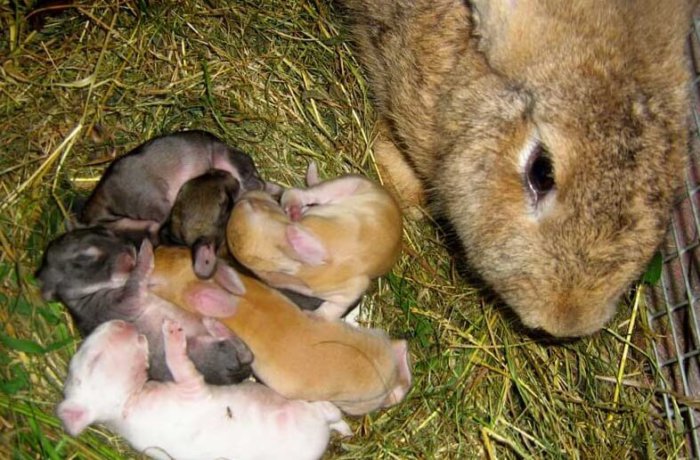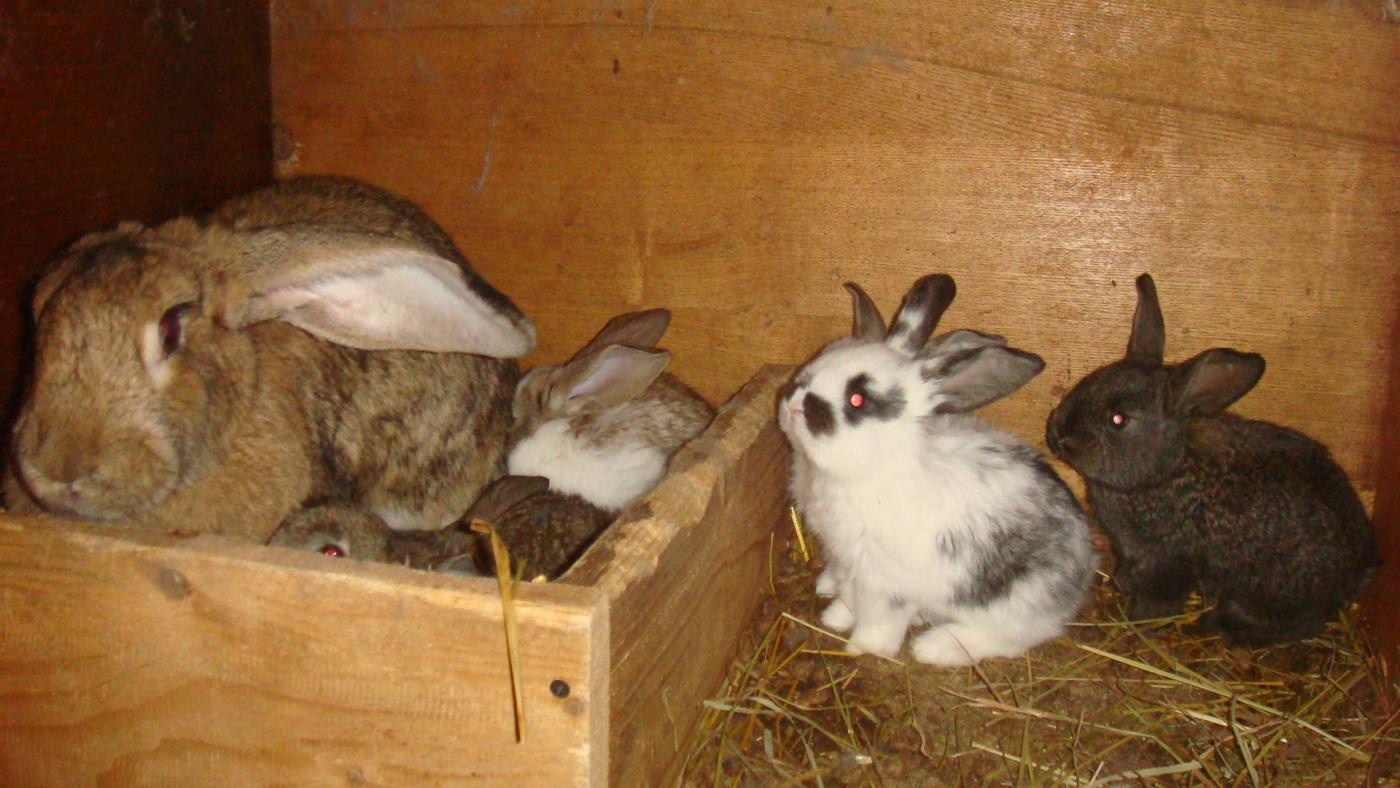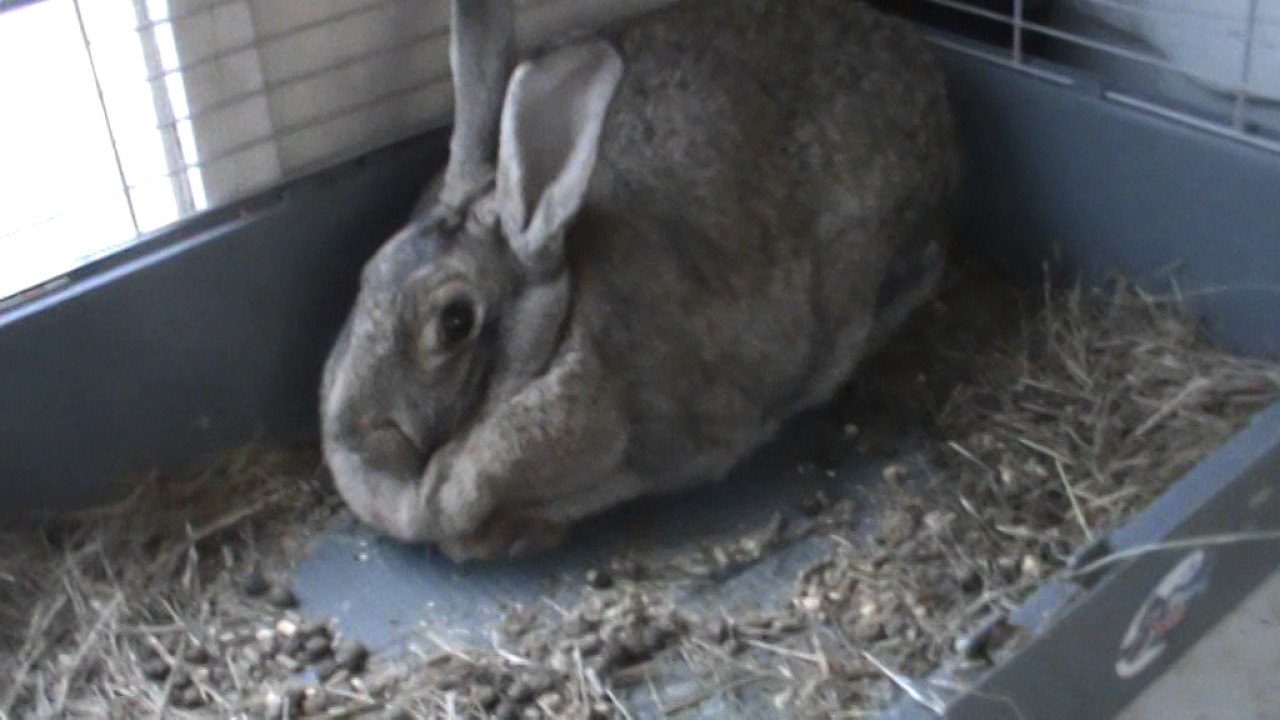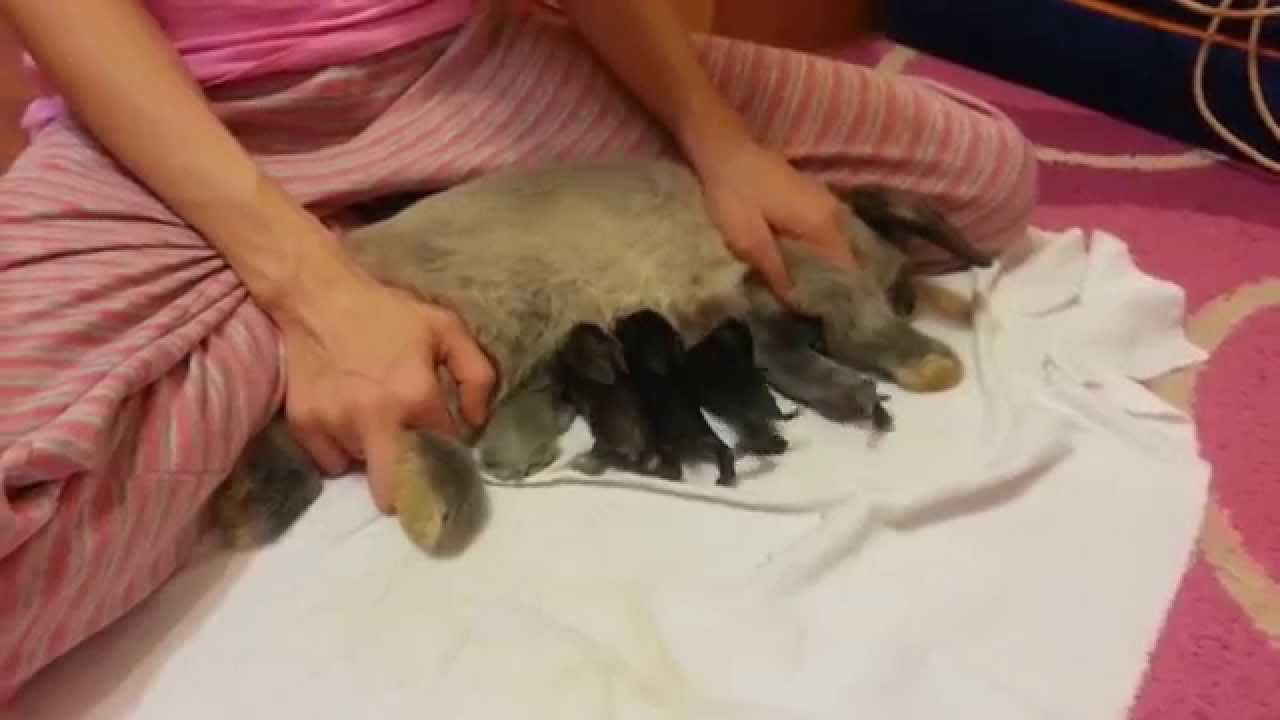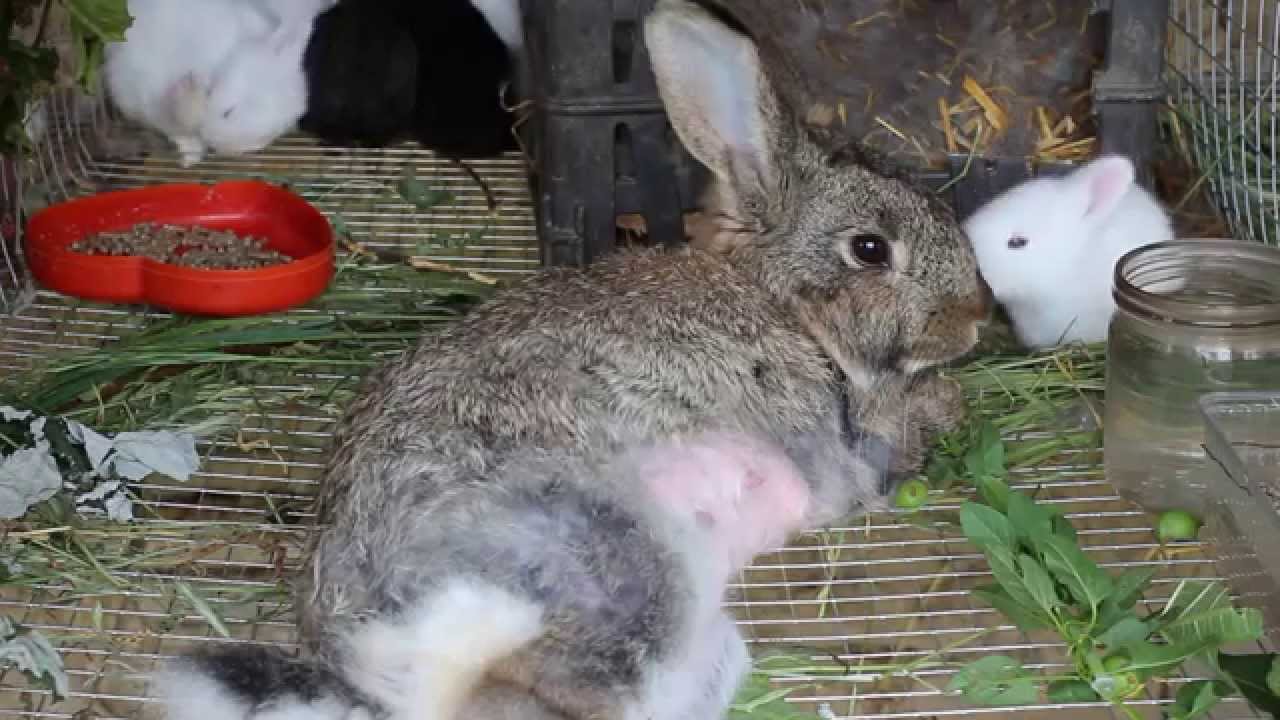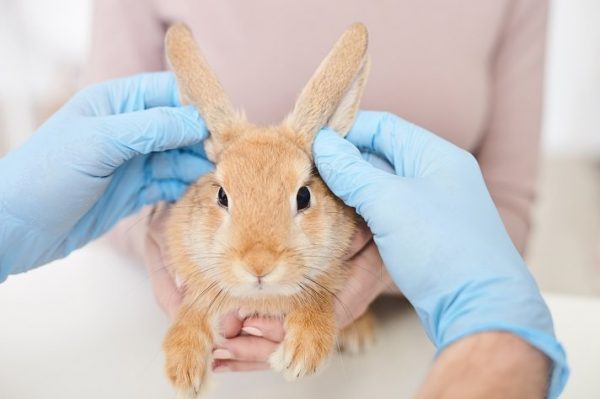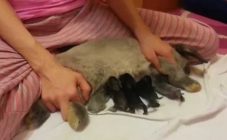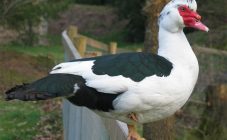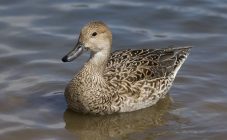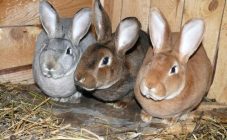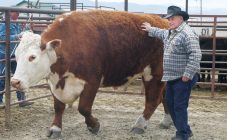Content:
Rabbits are pregnant for 30 days. Sometimes, if there are many babies, labor may start a little earlier. Every rabbit breeder needs to know all the nuances of the birth and lactation period of the rabbit's life.
Maternal secrets of bunnies
A week before giving birth, the female begins to build a nest from hay and her own down. She pulls the fluff out of the belly, around the nipples. This is done not only to keep the cubs warm and comfortable, but also so that they can easily get to milk. After all, babies are born blind, naked and completely helpless.
Usually 4-8 rabbits are born in a litter. But there are cases when there may be 16 of them. Okrol, as a rule, begins at night, closer to dawn. If everything is fine, then the breaks between the babies born is no more than 10 minutes. Sometimes there are minor delays. If the female cannot give birth all day, you need to seek help from a veterinarian.
Immediately after giving birth, the newly-made mother eats the afterbirth. She can eat a stillborn baby rabbit, which should not be allowed. The stillborn must be removed from the nest immediately. In this case, you must observe some precautions:
- Remove the mother from the nest box. This procedure must be performed every time the breeder wants to get to the babies.
- Wash your hands with laundry soap. You can use the baby, without fragrances. Then they need to be rubbed with fluff from the nest.
It often happens that after the mating, the female starts hunting. It can proceed both calmly and in a violent form - it rushes around the cage, completely forgetting about the rabbits. If the breeder is set for further breeding, it must be placed with the male for mating. Even after mating, the rabbit perfectly looks after newborns.
Feeding rabbits
She begins to feed the offspring after childbirth. But it so happens that she refuses to do it. Not just seeing, but at least noticing how the rabbits feed the rabbits is very rare. But you can understand that the cubs are hungry by their behavior. Well-fed rabbits have a smooth skin, a round, full belly and healthy sleep. If they are hungry, they constantly squeak, crawl and have an unsightly, disheveled appearance. Children can be malnourished for several reasons:
- The mother has too little milk. Most likely, this is a consequence of an improper diet during the prenatal period and after birth. You can stimulate lactation by increasing the amount of juicy root crops in the feed, adding scalded nettle, dried dill, parsley, carrot tops. Any dairy products stimulate lactation well: whey and milk itself.
- There are more rabbits in the litter than the female can feed. Experienced rabbit breeders mate several females at the same time. In this case, you can put a bunny from a large family where little cubs were born. The adoptive mother will not detect forgery if the foundling is first wiped with fluff from the new nest.
- The rabbit refuses to feed. This happens when hunting wildly.What to do is described above. Another similar thing can happen if the female is young and this is her first birth. In this case, forced feeding will help - babies are placed on the held female. Often this method awakens a maternal instinct in careless rabbits.
If all else fails, then the kids will have to be additionally fed. For this, mixtures for puppies or kittens are used. You can find out about the availability of such mixtures at the pet store or veterinary pharmacy. You can also purchase a syringe with a feeding pipette there. At first, the rabbits will resist, refuse the rubber "nipple", but they will quickly get used to it and even begin to recognize the breadwinner as soon as they are taken in hand. In the process of feeding, the eaten cubs should be put aside so as not to get confused and not to leave someone without a portion of milk.
How many times does the rabbit feed the cubs
During the normal course of the postpartum period, the female is not constantly in the nest. In its natural habitat, it, having a strong smell, moves away from the offspring, feeds under the shade of trees and watches the burrow. A similar thing happens in the cage - the rabbit will sit quietly, feed and do, it would seem, not at all what a young mother should do. But with the onset of darkness, the rabbit will definitely dive into the birth box and feed the babies.
In general, the data on how many times a day a rabbit feeds newborn rabbits varies slightly. Some feed twice a day, others five. It is very difficult to catch a female following this process, and if you count by the number of visits to the nest, she can dive into it just like that. You should not immediately go into the drawer and check the tummies of babies. Better to bother them as little as possible.
How many babies can a rabbit feed, and how long will she feed them
There is no exact data on how many rabbits a rabbit can feed. It depends on such factors:
- Physical condition;
- Feeding;
- Genetic predisposition.
Rabbit breeders have such a rule - do not leave more cubs under the mother than she has nipples. In this case, all the kids will have food. That is why they are trying to make sure that several females give birth at the same time in the rabbitry - so that there is something to do with the "extra" babies.
Breast rabbits, born naked and blind, are covered with fur and become sighted by the 12th day of life. Only after that do they try to get out of the nest box little by little. By three weeks, they begin to sample "adult" food. But the female can feed them up to three months. In the wild, a rabbit has a new offspring in 35-40 days (the number of births is up to 11 per year) and still the firstborn, no, no, and they dive to the mother. With the cellular content of young eared rodents, it is customary to remove from the mother's nest at the age of one and a half months.
What is sick of a rabbit while feeding rabbits
During the feeding period, the female may categorically refuse to approach the babies. By her behavior, you can immediately determine what is wrong with her health. Most often, this behavior is caused by developing mastitis - an inflammatory process in the mammary glands. The reasons due to which this disease develops:
- Under-expressed milk. There is more of it than rabbits can eat;
- An infection in the rabbit's body or a parasitic disease;
- Insanitary condition in the cage;
- Hypothermia or stress of the animal.
With mastitis, the mammary gland becomes hard. At the time of feeding, pain appears. If left untreated, purulent processes may begin.
You can try to overcome the disease in the initial stage. You just need a gland massage. The best "masseurs" are the young themselves.To do this, the female must be laid down and held firmly. Rabbits, sucking milk, massage the gland. With a certain degree of luck, this therapy can help.
But, unfortunately, in most cases, especially when precious time is lost, it is impossible to do without the intervention of a veterinarian. Often, offspring from a sick rabbit has to be removed and either put it in other nests, or fed artificially. In breeding, as a rule, such rabbits do not take part further.
On an industrial scale, females who are sick or prone to mastitis are removed from the herd without long and expensive treatment. An amateur rabbit breeder who does not want to lose the breeder is recommended to regularly check the mammary glands of rabbits.
But not only mastitis can disturb a nursing mother. There are also nipple diseases. Coarsening can occur from the premature appearance of milk in the glands. Injuries appear from baby bites. Such ailments are treated by lubricating the nipples with any vegetable oil (preferably olive oil) and gentle massage. This is the list of what else the rabbit can get sick with while feeding the rabbits, perhaps, ends. The rest of the diseases that rabbits are susceptible to during lactation can manifest themselves in other periods of life. And the feeding process is not the reason for their development.
In conclusion, we can say that with proper care, the animal is able to independently cope with the rearing of offspring. And all the complications appear either due to genetic predispositions, or if the rules for keeping eared pets are not followed.
